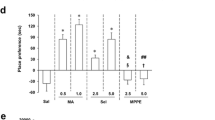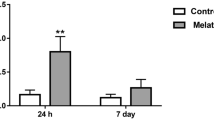Abstract
Several laboratories recently have reported that melatonin may possess neuroprotective properties. The present paper presents the results of our studies on the long-termin vivo effects of melatonin in a well-defined neurotoxicity model using 1-methyl-4-phenyl-l,2,3,6-tetrahydropyridine (MPTP) in the C57BL/6 mouse. MPTP is bioactivated by brain monoamine oxidase B (MAO-B) to its neurotoxic pyridinium metabolite l-methyl-4-phenylpyridi-nium (MPP+) which destroys dopaminergic nerve terminals leading to the depletion of neostriatal dopamine (DA) and 3,4-dihydroxyphenylacetic acid (DOPAC). Our initial study compared striatal DA and DOPAC levels in MPTP-only-treated animals and animals treated with melatonin 30 min prior to and 3 times hourly post-MPTP. DA/DOPAC levels measured 7 days after MPTP were similar in both groups. A second study was designed to address the possibility that melatonin cleared from the brain prior to MPP+. Animals, that had been administered the same regimen of melatonin as in the first study plus a fourth post-MPTP melatonin dose, were maintained on melatonin in drinking water until 5 days post-MPTP. Striatal DA/DOPAC levels of these melatonin-plus-MPTP treated animals also were the same as the MPTP-only-treated animals.In vitro studies confirmed that melatonin is not an inhibitor of MAO-B. These data demonstrate that melatonin does not have any significant protective effects against the long-term striatal DA and DOPAC depletion induced by MPTP in the C57BL/6 mouse.
Similar content being viewed by others
Reference
Abuja, P.M., Liebmann, P., Hayn, M., Schauenstein, K. and Esterbauer, H. (1997) Antioxidant role of melatonin in lipid peroxidation of human LDL. FEBS Lett.413, 289–293.
Acuna-Castroviejo, D., Coto-Montes, A., Gaia Monti, M., Ortiz, G.G. and Reiter, R.J. (1997) Melatonin is protective against MPTP induced striatal and hippocampal lesions. Life Sci.60, PL23-PL29.
Ali, S.F., Martin, J.L., Black, M.D. and Itzhak, Y. (1999) Melatonin, an antioxidant, protects against metham-phetamine but not against MPTP-induced dopaminergic neurotoxicity. J. Neurochem.73(Suppl.), S190-S190.
Arendt, J. (1995) Melatonin and the Mammalian Pineal Gland. Chapman & Hall, London.
Bertuglia, S., Marchiafava, P.L. and Colantuoni, A. (1996) Melatonin prevents ischemia reperfusion injury in hamster cheek pouch microcirculation. Cardiovasc. Res.31, 947–952.
Bezard, E., Dovero, S., Bioulac, B. and Gross, C. (1997a) Effects of different schedules of MPTP administration on dopaminergic neurodegeneration in mice. Exp Neurol.148, 288–292.
Bezard, E., Dovero, S., Bioulac, B. and Gross, C. (1997b) Kinetics of nigral degeneration in a chronic model of MPTP-treated mice. Neurosci. Lett.234, 47–50.
Cagnacci, A., Elliott, J.A. and Yen, S.S. (1992) Melatonin: a major regulator of the circadian rhythm of core temperature in humans. J. Clin. Endocrinol. Metab.75, 447–452.
Cagnoli, CM., Atabay, C, Kharlamova, E. and Manev, H. (1995) Melatonin protects neurons from singlet oxygen-induced apoptosis. J. Pineal Res.18, 222–226.
Capsoni, S., Stankov, B.M. and Fraschini, F. (1995) Reduction of regional blood flow by melatonin in young rats. Neuroreport6, 1346–1348.
Castagnoli, K., Palmer, S., Anderson, A., Bueters, T. and Castagnoli Jr., N. (1997a) The neuronal nitric oxide synthase inhibitor 7-nitroindazole also inhibits the monoamine oxidase-B-catalyzed oxidation of l-methyl-4-phenyl-l, 2, 3, 6-tetrahydropyridine. Chem. Res. Toxicol.10, 364–368.
Castagnoli Jr., N., Rimoldi, J.M., Bloomquist, J. and Castagnoli, K.P. (1997b) Potential metabolic bioactivation pathways involving cyclic tertiary amines and azaarenes. Chem. Res. Toxicol.10, 924–940.
Castagnoli Jr., N., Chiba, K. and Trevor, A.J. (1985) Potential bioactivation pathways for the neurotoxin l-methyl-4-phenyl-l, 2, 3, 6-tetrahydropyridine (MPTP). Life Sci.36, 225–230.
Cazevieille, C, Safa, R. and Osborne, N.N. (1997) Melatonin protects primary cultures of rat cortical neurones from NMDA excitotoxicity and hypoxia/reoxygenation. Brain Res.768, 120–124.
Di, W.L., Kadva, A., Johnston, A. and Silman, R. (1997) Variable bioavailability of oral melatonin.N. Engl.. Med.336, 1028–1029.
Ebadi, M., Srinivasan, S.K. and Baxi, M.D. (1996) Oxidative stress and antioxidant therapy in Parkinson’s disease. Prog. Neurobiol.48, 1–19.
Gerlach, M. and Riederer, P. (1996) Animal models of Parkinson’s disease: an empirical comparison with the phenomenology of the disease in man. J. Neural. Transm.103, 987–1041.
Gerlach, M., Riederer, P., Przuntek, H. and Youdim, M.B. (1991) MPTP mechanisms of neurotoxicity and their implications for Parkinson’s disease.Eur.. Pharmacol.208, 273–286.
German, D.C., Nelson, E.L., Liang, C.L., Speciale, S.G., Sinton, CM. and Sonsalla, P.K. (1996) The neurotoxin MPTP causes degeneration of specific nucleus A8, A9, and A10 dopaminergic neurons in the mouse. Neurodegeneration5, 299–312.
Gilad, E., Cuzzocrea, S., Zingarelli, B., Salzman, A.L. and Szabo, C. (1997) Melatonin is a scavenger of peroxynitrite. Life Sci.60, PL169-PL174.
Giusti, P., Francheschini, D., Petrone, M., Manev, H. and Floreani, M. (1996a)In vitro andin vivo protection against kainate-induced excitotoxicity by melatonin. J. Pineal Res.20, 226–231.
Giusti, P., Lipartiti, M., Francheschini, D., Schiavo, N., Floreani, M. and Manev, H. (1996b) Neuroprotection by melatonin from kainate-induced excitotoxicity in rats. FASEBJ.10, 891–896.
Heikkila, R.E. and Sonsalla, P.K. (1991) The MPTP-treated mouse as a model of parkinsonism: how good is it? Neurochem. Int.20, 299–303.
Heikkila, R.E., Sieber, B.A., Manzino, L. and Sonsalla, P.K. (1989) Some features of the nigrostriatal dopaminergic neurotoxin l-methyl-4-phenyl-l, 2, 3, 6-tetrahydropyridine (MPTP) in the mouse. Mol. Chem. Neuropathol.10, 171–183.
Iacovitti, L., Stull, N.D. and Johnston, K. (1997) Melatonin rescues dopamine neurons from cell death in tissue culture models of oxidative stress. Brain Res.768, 317–326.
Itzhak, Y., Martin, J.L., Black, M.D. and Ali, S.F. (1998) Effect of melatonin on methamphetamine- and l-methyl-4-phenyl-1, 2, 3, 6-tetrahydropyridine-induced dopaminergic neurotoxicity and methamphetamine-induced behavioral sensitization. Neuropharmacology37, 781–791.
Jackson-Lewis, V, Jakowec, M., Burke, R.E. and Przedborski, S. (1995) Time course and morphology of dopaminergic neuronal death caused by the neurotoxin 1-methyl-4-phenyl-l, 2, 3, 6-tetrahydropyridine. Neurodegeneration4, 257–269
Jin, B.K., Shin, D.Y., Jeong, M.Y., Gwag, M.R., Baik, H.W., Yoon, K.S., Cho, Y.H., Joo, W.S., Kim, Y.S. and Baik, H.H. (1998) Melatonin protects nigral dopaminergic neurons from l-methyl-4-phenylpyridinium (MPP+) neurotoxicity in rats. Neuroscience Lett.2, 61–64.
Kim, Y.S., Joo, W.S., Jin, B.K., Cho, Y.H., Baik, H.H. and Park, C.W. (1998) Melatonin protects 6-OHDA-induced neuronal death of nigrostriatal dopaminergic system. Neuroreport9, 2387–2390.
Le Bars, D., Thivolle, P., Vitte, P.A., Bojkowski, C, Chazot, G., Arendt, J., Frackowiak, R.S. and Claustrat, B. (1991) PET and plasma pharmacokinetic studies after bolus intravenous administration of [11C]melatonin in humans. Int.J. Rad. Appl. Instrum.18, 357–362.
Lezoualc’h, F., Skutella, T, Widmann, M. and Behl, C. (1996) Melatonin prevents oxidative stress induced cell death in hippocampal cells. Neuroreport7, 2071–2077.
Lezoualc’h, E, Sparapani, M. and Behl, C. (1998) N-acetylserotonin (normelatonin) and melatonin protect neurons against oxidative challenges and suppress the activity of the transcription factor NF-kappaB. J. Pineal Res.24, 168–178.
Livrea, M.A., Tesoriere, L., D’Arpa, D. and Morreale, M. (1997) Reaction of melatonin with lipoperoxyl radicals in phospholipid bilayers. Free Radio. Biol. Med.23, 706–711.
Manev, H., Uz, T, Kharlamov, A. and Joo, J.Y. (1996) Increased brain damage after stroke or excitotoxic seizures in melatonin-deficient rats. FASEB J.10, 1546–1551.
Melchiorri, D., Reiter, R.J., Sewerynek, E., Chen, L.D. and Nistico, G. (1995) Melatonin reduces kainate-induced lipid peroxidation in homogenates of different brain regions. FASEBJ.9, 1205–1210.
Penev, P.D. and Zee, PC. (1997) Melatonin: a clinical perspective. Ann. Neurol.42, 545–553.
Pierpaoli, W. and Regelson, W. (1994) Pineal control of aging: effect of melatonin and pineal grafting on aging mice. Proc. Natl. Acad. Sci. USA91, 787–791.
Pierpaoli, W., Dall’Ara, A., Pedrinis, E. and Regelson, W. (1991) The pineal control of aging. The effects of melatonin and pineal grafting on the survival of older mice. Ann. N.Y. Acad. Sri.621, 291–313.
Pitts, S.M., Markey, S.P., Murphy, D.L. and Weisz, A. (1986) Recommended practices for the safe handling of MPTP. In MPTP: A Neurotoxin Producing a Parkinsonian Syndrome; Markey, S.P, Castagnoli Jr., N., Trevor, A.J. and Kopin, I.J. (Eds). Academic Press: New York, pp. 703–716.
Reiter, R., Tang, L., Garcia, J.J. and Munoz-Hoyos, A. (1997) Pharmacological actions of melatonin in oxygen radical pathophysiology. Life Sci.60, 2255–2271.
Reiter, R.J. (1995) Functional pleiotropy of the neurohormone melatonin: antioxidant protection and neuroendocrine regulation. Front. Neuroendocrinal.16, 383–415.
Salach, J.I. and Weyler, W. (1987) Preparation of the flavincontaining aromatic amine oxidases of human placenta and beef liver. Methods in Enzymology; Kaufman, S. (Ed.), Academic Press: London, Vol. 142, pp. 627–637.
Schmidle, C.J. and Mansfield, R.C. (1956) The aminomethylation of olefins. IV. The formation of 1-alkyl-4-aryl-l, 2, 3, 6-tetrahydropyridines. J. Am. Chem. Soc.78, 425–428.
Segel, I.H. (1993)Enzyme Kinetics, Wiley, New York, pp. 136–143.
Shaikh, A.Y., Xu, J., Wu, Y, He, L. and Hsu, C.Y (1997) Melatonin protects bovine cerebral endothelial cells from hyperoxia induced DNA damage and death. Neurosci. Lett.229, 193–197.
Turjanski, A.G., Rosenstein, R.E. and Estrin, D.A (1998) Reactions of melatonin and related indoles with free radicals: a computational study. J. Med. Chem.41, 3684–3689.
Van der Schyf, C.J., Castagnoli, K., Palmer, S. and Castagnoli Jr., N. (1998) Melatonin fails to protect against MPTP-induced dopamine depletion in mouse striatum. Toxicol. Sci.42(1-S), 328.
Willis, G.L. and Armstrong, S.M. (1999) A therapeutic role for melatonin antagonism in experimental models of Parkinson’s disease. Physiol. Behav.66, 785–795.
Winkler, A., Buzas, B., Siems, W.E., Heder, G. and Cox, B.M. (1998) Effect of ethanol drinking on the gene expression of opioid receptors, enkephalinase, and angiotensinconverting enzyme in two inbred mice strains. Alcohol Clin. Exp. Res.,22, 1262–1271.
Yeleswaram, K., McLaughlin, L.G., Knipe, J.O. and Schabdach, D. (1997) Pharmacokinetics and oral bioavailability of exogenous melatonin in preclinical animal models and clinical implications. J. Pineal Res.22, 45–51.
Author information
Authors and Affiliations
Corresponding author
Additional information
Presented in part at the 37th annual Meeting of the Society of Toxicology, Seattle, March 1–5, 1998 (see Van der Schyfet al., 1998).
Rights and permissions
About this article
Cite this article
van der Schyf, C.J., Castagnoli, K., Palmer, S. et al. Melatonin fails to protect against long-term MPTP-Induced dopamine depletion in mouse striatum. neurotox res 1, 261–269 (1999). https://doi.org/10.1007/BF03033256
Received:
Revised:
Issue Date:
DOI: https://doi.org/10.1007/BF03033256




